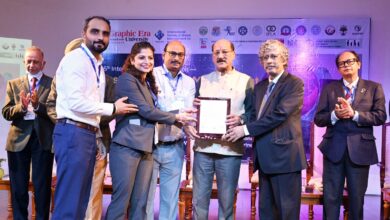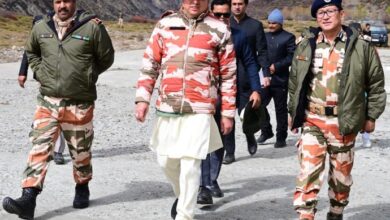A bird’s view of the keenly contested MCD Elections in Delhi

A bird’s view of the keenly contested MCD Elections in Delhi
By Rashme Sehgal
New Delhi, Dec 12
The East Patel Nagar (EPN) where I live was one of the centres which witnessed a pitched battle fought by AAP, BJP and the Congress for the keenly contested Municipal Corporation of Delhi elections.
The run up for the elections saw loudspeaker carrying scooter rickshaws drive through the streets extolling the residents to vote for one of the three parties, depending on which party had hired that party scooter rickshaw for that day.
The AAP had an edge on the decibel score primarily because my immediate neighbor happened to be AAP minister Raaj Kumar Anand who symbolizes the present political leader of today. Anand never made any effort to interact with the holloi polloi of EPN. Unlike the politicians of yore, who would have an unending stream of public coming to their house from six o`clock in the morning wanting a `sifarish’ for a job, a phone connection or a child admission, Anand has never stepped out of the four walls of his house to interact with the public at large.
The only time we come to know he was present was when a series of white SUVs could be seen parked outside his house at night. My former neighbor, a college professor, was aghast at how Anand’s young golden retriever remains tied outside the gate of his house right through the burning summer months and the freezing cold winter nights.
But election time is a different kettle of fish. Since Anand never stepped out to interact with the public in this key constituency he made up for his absence by ensuring an unending stream of scooter rickshaws drove through the streets of EPN all day beseeching the public to vote for their candidate Dr. Shelly Oberoi who was contesting under the immediate `guidance’ of Raghav Chadha, Rajya Sabha MP who incidentally is a resident of the neighbouring Rajinder Nagar colony.
The RSS-BJP has a strong base in this part of Delhi primarily because many of these colonies were built to house refugees from erstwhile West Punjab who settled here following partition in 1947. Being a largely Punjabi business community, it was these refugee families that provided the first batch of prominent leaders in the BJP as it gained strength in Delhi namely Madan Lal
Khurana and VK Malhotra with the former being a chief minister of Delhi while the latter rose to be leader of opposition in the Delhi assembly for a good five years. Incidentally, Jhandewala which houses the RSS headquarters in north Delhi is very much part of this sprawling urban complex. So it was left to many of these old guard BJP leaders to return to the old style campaigning of going door-to-door and asking residents to vote for the BJP candidate Deepali Kapoor. They did so with a great deal of fanfare.
Dressed in orange bandgala waistcoasts and orange mufflers to ward off the cold and carrying BJP flags in their hands they told all and sundry, ` Saade candidate nu jitana ( Make our candidate win).’ The Congress candidate from here was Shakuntala Kumari obviously a last minute entry and a political novice. Like her party at large, she had no support on the ground and it was left to successive scooter rickshaw drivers to convey her taped message to this urban conglomerate. The state of the Congress party can be summed up from the fact that its leader did not know whether his name was registered in the voters list!
On the day of the elections, as has been the practice in the past, the BJP office volunteers set up a table outside my house at 9 am sharp. Manned by six white-haired volunteers, whose job was to check the name of every prospective voter to ensure that his name was on the voting list. The voter is then given a number to enter to the voting area where the EVMs have been kept and which this time around also was located in the nearby Kalindhi college.
Not to be outdone, Anand had a table placed outside his house manned by two AAP volunteers one of whom was a young Sardar. Two houses away, two Congress volunteers also set up a table on the road side. I watched from my balcony and found that during the next eight hours up to 5.30 pm, not one prospective voter was seen to go to their table. The rush was all around the BJP table.
Like typical Punjabis, the BJP volunteers drank copious cups of tea and ate chana bhature and samosas and jalebis and exchanged gossip, confident that they would win this time around again having headed the MCD for the last 15 years.
The voting booth inside Kalindi college was set up in an extremely streamlined fashion. A contingent of over twenty policemen, some armed, were manning this booth. The college authorities seemed to be all hospitality with white rexine sofa sets being laid out for the cops including five women cops, who in the evening were also feted with steaming hot tea and samosas.
There was some discrimination because the government employees requisitioned to man these booths were neither offered chai or snacks. The well heeled urban voter did not seem unduly excited because the vote percentage this time round was around 50 per cent.
The results of the 2022 MCD election, 134 AAP and 104 BJP turned out to be something of a cliffhanger with AAP not winning as easily as they had expected to do. For the Congress, the results were a disaster. They had no credible leader and no campaign on the ground. The BJP, by contrast, had conducted a high voltage campaign roping in seven chief ministers and all their cabinet ministers at the centre with BJP president JP Nadda doing door-to-door campaigning. The nine tickets the Congress wrested were largely from Muslim and Dalit voters.
What stopped the Congress to come up with a credible campaign is anyone’s guess. `They love committing hara-kiri as they have done successfully with one election after another,’ is what one Congress loyalist pointed out with a sigh, It is to the AAP’s credit that they took on and won against this high power BJP machinery. Weightage to performance and credible delieverance in areas of health, education, electricity and water went in AAP’s favour and it was obvious that the Delhi public wanted a change.
Of course the `hit’ jobs conducted by the BJP against two top AAP leaders Manish Sisodia and Satyendra Jain had its impact. Both AAP leaders were accused of corruption and are presently under investigation by Enforcement Directorate and Central Bureau of Investigation. These allegations did impact the psyche of the voters because in Sisodia’s Patparganj assembly seat, the BJP won three of the four MCD wards while in Jai’s Shakur Basti assembly seat, the BJP won all three MCD wards.
All I can say is that these MCD elections played out more like almost national elections. What was at stake, (apart from directly impacting thelives of Delhi’s 20 crore population) was a hand in the till of the Rs 15,000 crore annual budget of the Delhi MCD.
In conclusion one would like to ask is soft Hindutva now an ingrained part of the AAP politics and can this act as an effective counter to the hardline Hindutva nationalism adopted by the ruling party. But now that Kejriwal has also set up a `double engine’ sarkar, he will have no excuses to give for non-performance. The Prime Minister runs a `double engine’ sarkar across several states but is in the fortunate position to win election after election without having to give this level of accountability.
( Rashme Sehgal is an independent senior journalist.)




